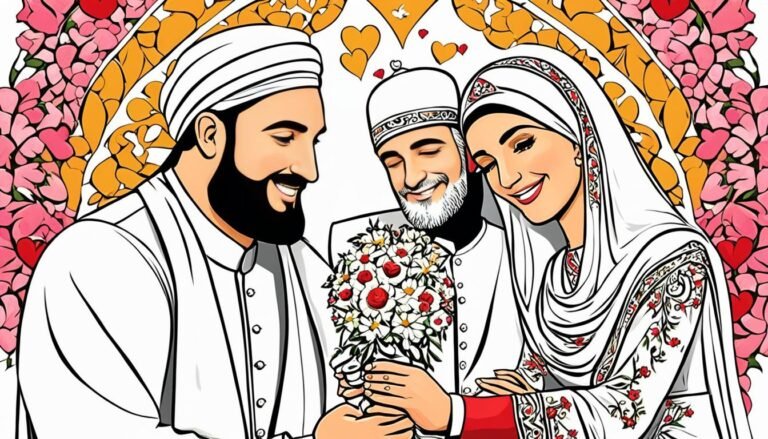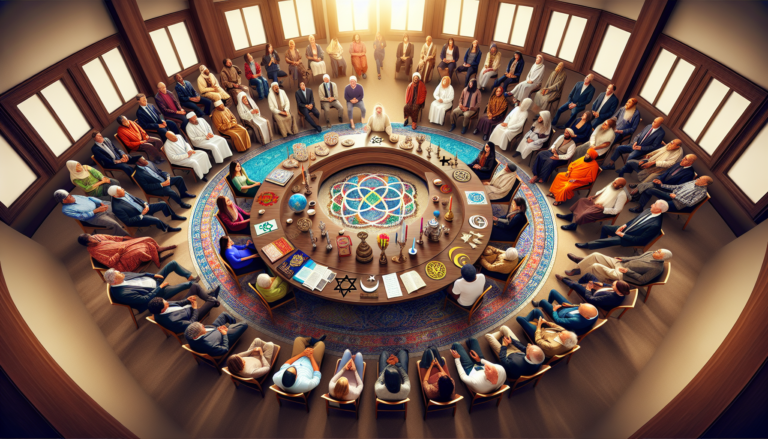The Language of Faith: Unveiling the Definition of Interreligious Dialogue
Understanding Interreligious Dialogue
Interreligious dialogue is all about bringing people from different faiths together to chat, learn, and grow. Let’s break down what it means, why it matters, and how it all started.
What It Is and Why It Matters
Interreligious dialogue is like a two-way street where folks from different religions talk and listen to each other. It’s not about converting anyone or ditching your own beliefs. Instead, it’s about sharing your faith and being open to others’ perspectives. Think of it as a way to build respect, understanding, and teamwork among people from various religious backgrounds.
The goal here is to create bridges, not walls. By talking and listening, people can bust myths, learn new things, and appreciate the richness of different faiths. It’s a way to promote peace and harmony in our communities.
How It All Started
The idea of interreligious dialogue has roots in some key moments in history. For Catholics, a big turning point was the “Nostra Aetate” document from the Second Vatican Council in 1965. This document encouraged Catholics to talk with people from other religions and respect their beliefs.
Since then, the Catholic Church has put out more documents to guide these conversations. Some of these include “Dialogue in Truth and Charity” (2014), “Dialogue and Proclamation” (1991), and “Dialogue and Mission” (1984). These papers offer tips and frameworks for meaningful and respectful dialogue.
But it’s not just a Catholic thing. Scholars and religious leaders from all over have been pushing for interreligious dialogue. Hans Küng, a big name in this field, famously said, “There will be no peace among the nations without peace among the religions. There will be no peace among the religions without dialogue among the religions.” His words remind us how crucial these conversations are for global peace and understanding.
Today, there are tons of organizations and conferences dedicated to promoting interreligious dialogue. These platforms give people from different faiths a chance to come together, share their stories, and have meaningful discussions. If you want to see some real-life examples, check out our article on interfaith dialogue examples.
In a nutshell, interreligious dialogue is a powerful tool for fostering understanding and peaceful coexistence among people of different faiths. By engaging in these conversations, we can break down prejudices, expand our horizons, and help build a more inclusive and harmonious society.
Key Figures in Interfaith Dialogue
Interfaith dialogue has been shaped by some remarkable folks who’ve dedicated their lives to bridging gaps between different religious communities. Two standout figures in this field are Duncan Black Macdonald and Hans Küng.
Duncan Black Macdonald
Duncan Black Macdonald was a trailblazer in promoting understanding between Christianity and Islam. As a pioneer of Arabic and Islamic studies in the U.S., he worked tirelessly to educate missionaries about the Muslim faith and traditions. Macdonald focused on the common ground between Christianity and Islam, aiming to build cultural competency and highlight shared values.
Macdonald encouraged Christians to seek spiritual friendships with Muslims, fostering a love for Islam while respecting doctrinal differences. He believed that by building bridges of understanding, Christians and Muslims could unite against secular materialism and promote peace (Hartford International University).
To honor Macdonald’s legacy, the Macdonald Center for the Study of Islam and Christian-Muslim Relations was founded at Hartford International University in 1973. The center aims to challenge stereotypes and prejudices about Islam and offers an Islamic Studies specialization in their MA in Interreligious Studies program, contributing to education and understanding in interfaith dialogue (Hartford International University).
Hans Küng
Hans Küng, another giant in interfaith dialogue, served as a Professor of Ecumenical Theology and the President of the Global Ethic Foundation. He made significant strides in advocating for dialogue among different religions.
Küng famously stated, “There will be no peace among the nations without peace among the religions. There will be no peace among the religions without dialogue among the religions.” This powerful message underscores the importance of interreligious dialogue in fostering global peace and understanding (Wikipedia).
Throughout his career, Küng emphasized the ecumenical aspect of interreligious dialogue, recognizing the importance of collaboration between different Christian denominations. The Pontifical Council for Interreligious Dialogue (PCID) maintains a relationship with the World Council of Churches, working together on initiatives to promote interreligious dialogue (Dicastery for Promoting Integral Human Development).
The contributions of Duncan Black Macdonald and Hans Küng have been pivotal in advancing interreligious dialogue. Their work continues to inspire individuals and organizations dedicated to fostering understanding, respect, and cooperation among diverse religious communities. For more examples of interfaith dialogue, check out our article on interfaith dialogue examples.
Approaches to Interfaith Dialogue
Interfaith dialogue can happen on a personal level or through organized efforts. Each way brings its own perks for understanding and working together across different religions.
Personal vs. Organized Efforts
When it comes to personal interfaith dialogue, it’s all about those one-on-one chats or small group conversations. Think of meeting someone at a community event, a social gathering, or even just a casual coffee chat. These interactions let people dive into each other’s beliefs and practices, building relationships based on respect and shared experiences.
On the flip side, organized interfaith dialogue involves bigger efforts by religious groups, organizations, and leaders. These are the folks setting up conferences, workshops, and joint projects. The goal? To tackle common issues, promote shared values, and find solutions to social problems. It’s a chance for different religious communities to come together, learn from each other, and work towards common goals.
Both personal and organized approaches are crucial for fostering understanding and peaceful coexistence. Through dialogue, we can bust stereotypes, challenge misconceptions, and build meaningful relationships based on empathy and respect.
Types of Interfaith Dialogues
Interfaith dialogues can take many shapes, depending on what the participants want to achieve. Here are some common types:
-
Scriptural Dialogues: These focus on religious texts and interpretations. Participants dive into their sacred texts, comparing and analyzing to better understand their own faith and others’.
-
Ethical Dialogues: Here, the talk is all about ethical principles and moral values shared across religions. Participants explore common ground and discuss how to handle ethical dilemmas in society.
-
Social Action Dialogues: These are all about rolling up sleeves and working together on social issues. Folks from different faiths team up for community projects, humanitarian efforts, and advocacy campaigns.
-
Religious Leaders Dialogues: When religious leaders get together, they bring a lot of influence. These dialogues allow leaders to exchange ideas and address challenges faced by their communities, often shaping public opinion and interfaith relations.
By understanding these different approaches, individuals and institutions can pick the best methods to foster meaningful engagement and promote harmony among diverse religious communities. For more examples of interfaith dialogue initiatives and organizations, check out our articles on interreligious dialogue organizations and interreligious dialogue conferences.
Why Interreligious Dialogue Matters
Interreligious dialogue is like the secret sauce for peace, understanding, and sorting out conflicts among folks from different faiths. When people sit down and chat openly and respectfully, it helps close the gaps between diverse communities, making it easier for everyone to get along.
Spreading Peace and Understanding
One big reason why interreligious dialogue is a game-changer is its knack for spreading peace and understanding. Hans Küng nailed it when he said, “There will be no peace among the nations without peace among the religions. There will be no peace among the religions without dialogue among the religions”. When people from different religious backgrounds talk, they get to know each other’s beliefs, practices, and values better. This helps bust stereotypes, clear up misconceptions, and build empathy and respect. Through these conversations, folks can form real connections and work towards a more peaceful and inclusive society.
Sorting Out Conflicts with Conversation
Interreligious dialogue is also a lifesaver when it comes to sorting out conflicts that pop up due to different religious beliefs. When people stop talking, conflicts can blow up and create more divisions. But by keeping the conversation going, these conflicts can be tackled and resolved constructively. It takes guts and a willingness to listen, but when people from different religious perspectives come together, magic happens (Hartford International University). They can share their worries, hear each other out, and find common ground. By aiming for mutual respect and understanding, interreligious dialogue can help resolve conflicts and promote peaceful coexistence.
Interreligious dialogue isn’t just good for individuals; it has a ripple effect on society. By encouraging respect, mutual understanding, and teamwork between different religious traditions, it helps create a vibe of inclusivity and harmony. It also promotes learning about different religions, letting people pick up insights from each other’s beliefs and practices. Plus, it nurtures individuals who are all about dialogue, turning them into catalysts for positive change in their communities (Dicastery for Promoting Integral Human Development).
In a nutshell, interreligious dialogue is crucial for promoting peace, understanding, and resolving conflicts among people from different religious traditions. By keeping the conversation going, individuals can build bridges, foster empathy, and work towards a more peaceful and inclusive society. Its transformative power can create lasting change and promote harmonious coexistence among diverse communities.







